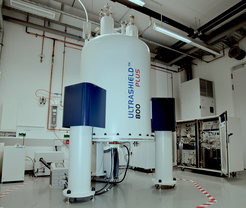
NMR Spectroscopy
The Nuclear Magnetic Resonance (NMR) Facility plays an important role in molecular structure determination, especially protein characterization, and conformational analysis. The instrumentation has primarily served the high-resolution research needs for investigators from the Departments of Protein Evolution and Integrative Evolutionary Biology. The services and equipment of the NMR facility are also available to other Max Planck research groups and academic institutions, especially within the University of Tübingen.

NMR provides information on the three-dimensional fold of proteins and the way proteins interact with other biomolecules. Finally, NMR spectroscopy gives insights into how protein complexes move and change conformation, aspects that are important for many enzymatic reactions. The information gained by NMR about biomolecular structure, interactions and dynamics allows us to understand how proteins are able to perform specific tasks in the cell.
NMR spectroscopy exploits a physical property called “spin” that certain atoms (e.g. 1H, 13C, and 15N) possess. If a protein is placed in a strong magnetic field, these atoms resonate at a “spin-frequency” that is unique to each atom. Since the resonance frequency depends on the chemical environment of the atom, it provides information about the atomic structure of the protein.
Mission
- Provide training and access to the facility, both standard and advanced use.
- Support the development of new pulse programs in the context of our R-factor strategy.
- Service for routine characterization of organic compounds and analysis of metabolomic profiles.
Equipment
600 MHz Bruker Avance-III
800 MHz Bruker Avance-III
